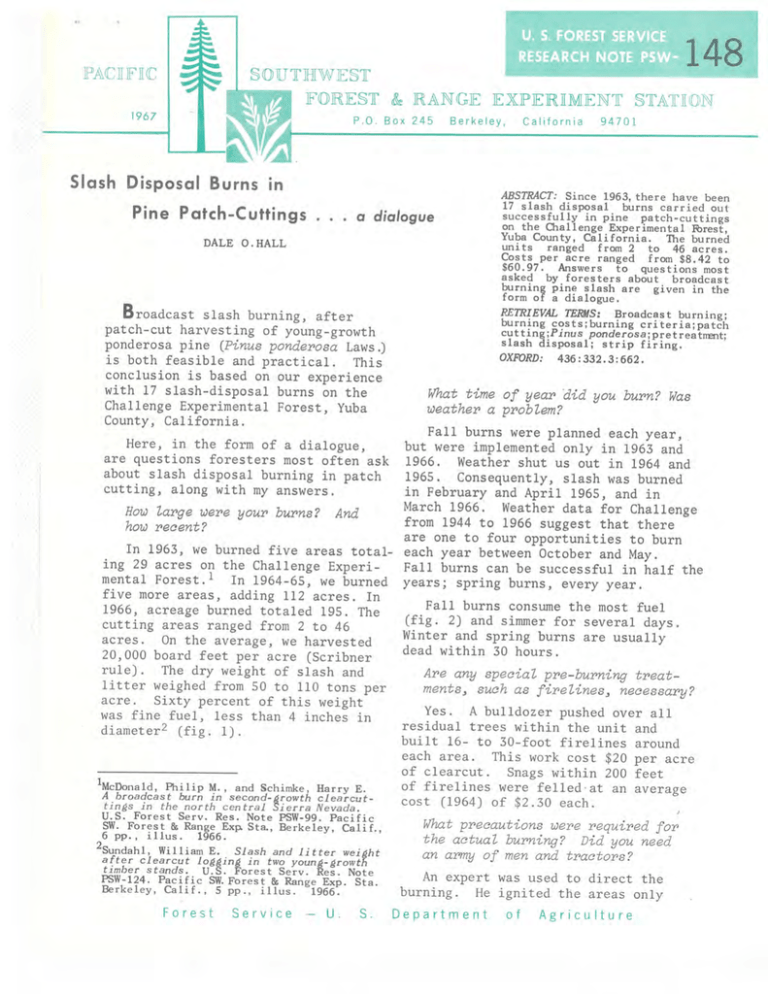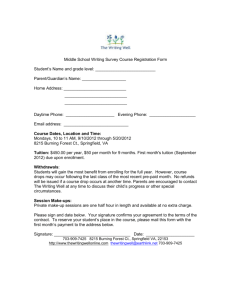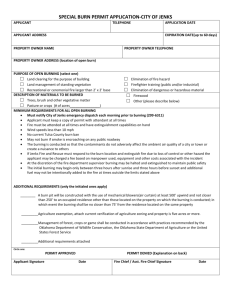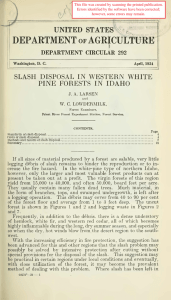148 Slash Disposal Burns in &
advertisement

148
§OlUTHW E§T
]FORE§T & RANGE EXPERTIMENT §TATTI ON
PACTIJFTICC
1967
P .O . Box 245
Berkeley ,
Slash Disposal Burns in
a dialogue
DALE O.HALL
Broadcast slash burning, after
patch-cut harvesting of young-growth
ponderosa pine (Pinus ponderosa Laws.)
is both feasible and practical. This
conclusion is based on our experience
with 17 slash-disposal burns on the
Challenge Experimental Forest, Yuba
County, California.
I
94701
ABSTRACT: Since 1963, there have been
Pine Patch-Cuttings ...
•
California
17 slash disposal burns carried out
successfully in pine patch-cuttings
on the Challenge Experimental FOrest,
Yuba County, California. The burned
units ranged from 2 to 46 acres.
Costs per acre ranged from $8.42 to
$60.97. Answers to questions most
asked by foresters about broadcast
burning pine slash are given in the
form of a dialogue.
RETRIEVAL TERMS: Broadcast burning;
burning costs;burning criteria;patch
cut ting;P inus ponderosa; pret rea trrEnt;
slash disposal; strip firing.
OXFORD: 436:332.3:662.
What time of year did you burn? Was
weather a probZem?
Fall burns were planned each year,
but were implemented only in 1963 and
1966. Weather shut us out in 1964 and
1965. Consequently, slash was burned
in February and April 1965, and in
March 1966. Weather data for Challenge
How Zarge were your burns? And
from 1944 to 1966 suggest that there
how reoent?
are one to four opportunities to burn
In 1963, we burned five areas total- each year between October and May.
Fall burns can be successful in half the
ing 29 acres on the Challenge Experimental Forest. 1 In 1964-65, we burned years; spring burns, every year.
five more areas, adding 112 acres. In
Fall burns consume the most fuel
1966, acreage burned totaled 195. The
(fig. 2) and simmer for several days.
cutting areas ranged from 2 to 46
Winter and spring burns are usually
acres. On the average, we harvested
dead within 30 hours.
20,000 board feet per acre (Scribner
Are any speoiaZ pre-burning treatrule). The dry weight of slash and
litter weighed from 50 to 110 tons per
ments~ suoh as fireZines~ neoessary?
acre. Sixty percent of this weight
Yes. A bulldozer pushed over all
was fine fuel, less than 4 inches in
residual
trees within the unit and
diameter 2 (fig. 1).
built 16- to 30-foot firelines around
Here, in the form of a dialogue,
are questions foresters most often ask
about slash disposal burning in patch
cutting, along with my answers.
1McDonald, Philip M., and Schimke, Harry E.
A broadcast burn in second-~rowth clearcuttings in the nor th cen tral Si erra Nevada.
U.S. Forest Servo Res. Note PSW-99. Pacific
SW. Forest & Range Exp. Sta., Berkeley, Calif.,
6 pp., illus. 1966.
2Sundahl, William E. Slash and litter weight
after clearcut logging in two young-growth
timber stands. U.S. Forest Servo Res. Note
PSW-124. Pacific SW.Forest & Range Exp. Sta.
Berkeley, Calif., 5 pp., illus. 1966.
Forest
Service
- u.
S.
each area. This work cost $20 per acre
of clearcut. Snags within 200 feet
of firelines .were felled'at an average
cost (1964) of $2.30 each.
What precautions were required for
the actuaZ burning? Did you need
an army of men and tractors?
An expert was used to direct the
burning. He ignited the areas only
Department
of
Agriculture
Figure 1.--A la-acre clearcut on the Challenge Experimental Forest,
California, with 55 tons of fine slash «4-inch d.i.b.) per acre, and
88 tons of total slash.
Figure 2.--In this fire-safe unit, 74 percent of the original 100 tons
of slash per acre have been removed.
-2-
when fuel and burning conditions fell
within his prescription (flg. 3) based
on the Wildland Fire Danger Rating 3
system.
1963. 0.. 00. 0008 acres
1964-65'0' 000.2 acres
1966 .... '0 .. 0.3 acres
Sufficient equipment and trained
manpower (table 1) were present to contain any escapes without calling for
outside assistance. As we gained experience our manpower requirements went
down. But, of course, the tougher the
weather conditions the more men we
needed.
Holding force deployment varied with
the day's burning method~5 which in
turn was predicated on weather, fuel,
topography, and burning conditions.
With strip firing on slopes, the fire
boss deployed his crew and equipment
at the fire head for ignition. As the
first 30- to 50-foot strip along the
head burned out--widening the effective
fire break--a new strip was ignited.
The holding crews worked down each
side concentrating most men near the
critical points while maintaining
surveillance around the entire fire
line. Tankers and tractors were held
on standby at each end of the fire
head. Portable and mobile radios
provided good communication among all
forces.
Did any of the fires get away in
spite of your heavy manning?
We have been guided by this premise:
Itlf fire will burn inside an area there
is a calculated risk of its burning
outside. I, By burning only under the
prescription, and taking fast suppression action, we have kept our "overburn" area low.
with "UJet ff season burning., how much
slash were you really able to burn?
Between 70 and 90 percent of the
fine fuels went up in smoke, but less
than 50 percent of the coarse fuels
(over 4 inches) burned. 6 This means
that the areas were essentially firesafe and the mineral soil exposed is
more than adequate for direct seeding.
However,the jack-strawed tops and logs
(fig. 2) do slow up foot-~logging seedsowers or planters.
What about erosion?
Soils on the Experimental Forest
are in the Aiken Series o They have
good internal drainage characteristics
and the erosion potential is low, On
slopes less than 20 percent, erosion
was rarely noticeable; on steeper slopes,
erosion was slight. A swift invasion
of shrubs and herbs rapidly reduces the
erosion potential .
No, not really 0 There was \;spotting "
You said broadcast burning is practiacross firelines in almost every burn,
cal. What about cost? Is it cheap
but the largest "escape" was less than
enough for the private landowner?
one acre o The total area burned outOur broadcast burning costs (table 3)
side initial firelines for each year
were:
Cost
was:
Per acre Per MBF
Acres
Date of burn:
" (dollars)
October 1963
60.97
2.10
29.0
80 04
February 1965
8.42
.4 1
\ 3u . S. Fo re st Service . lfildland fi re dange Jf
38,0
April
1965
21.60
1016
,rating. U.S . Fores t Se rv. , Pacific ~W o Fo r 1,37
36 . 24
March 1966
28 . 5
est & Range Exp . Sta .: Be r keley " CahL (vaL
pp , ) iUus. 1962 , (Rev. 1966,)
166.0
9 020
.73
November 1966
4Davis ? Kenneth P o FO ~Ast fire, c ont r ol and
use . 584 pp o, iIlus, New York: McGr aw -Hill
Book Co', 1959.
5Beaufait , William R. Pre s cri bed f ir e plan ~
n1ng in the intermountain wes t. U, S o Forest
Serv, Res , Pape r INT- 26 0 Inte r mountain For est & Range Exp , Sta ., Ogden , Utah o 27 pp . ;,
iUus" 1966 .
6Da t a on f Ie at Challenge , Calif on office o f
the Pacif c Southwest Fo rest and Range Expe Riment Stat on ~ U, S , Fo rest Service ,
-3-
I
FINE FUEL MOIS1URE
:~!t~!Ck
I06
Content
1-4·5
17
9
112
ill 1 13 116 1 21 1
1~
20 27
28 1 35T42
~4
41 48
'1 49"T5
~~
~8
I 6~
59 I 64 I 69 173 177 I 83
68 72 76 82 87
10
8
2.5
1.5 1. 5 2
4"
~--------------------,
II
12
15
93
1100
1 88
92
16
t
2
SPREAD FACTOR
Fine
2.5
14
13
12
3
II
2
1&
II
12
14
M
18
1&
~
12
13
15
17
1& 1&
5
16-20
13
14
16
18
1& 1&
21-25
14
15
17
1& 1& 1&
2. 5
26-30
8
31-35
36-40
8
41-45
46+
10
ill
ill
12
II
12
~
"
~
~
15
::.6
18
16
17
18+ 18..
U
~
W
~
1& 1& 18+
~
18+ 18+
~
ill
II
II
~
~
~
"
~
M
U
~
~
~
~
~
~~
~
II
11
12
12
1,
13
14
15
16
17
17
18
18+
1&~
12.+
18;
lE;.
1&
19
17
15
14
13
10
n
~
~
2l
20
26
~
~
22
20
26
~
~
26
~
n
22
~
W
M
~
TI
40
32
37
35
~
32
~
40
~
~
~
~
~
55
51
47
44
39
61
56
52
48
43
66
61
56
52
47
70
65
61
57
51
7r.
70
67
62
56
~
n
~
41
35
31
26
22
45
39
49
33
39
~
~
~
26
~
2l
22
~
26
~
U
"
~
20
22
~
M
W
2l
12
13
9
9
II
6
4
7
4
8
5
3
M
12
9
6
4
17
13
10
7
6
7
8
19
17
14
9
II
ill
11
9
ill
8
12
6
4
I 19 I 20 I
51
47
44
41
37
~
~
25
21
19
16
13
13
14
~
ill
Wind speed (m.p.h . )
10-2 p-s 16-7 1~9110 t IT 1 12 1131 141 15 1 16 1 17 1 18
1.5
11-15
5-10
:ruel
moisture
n
15
12
9
6
3
n
4
211
82
77
73
64
81
72
53
47
42
57
49
44
38
62
54
46
41
27
29
22
2 1,
16
12
8
13
33
25
28
36
30
II
20
16
13
25
20
15
8
9
5
6
24
19
14
10
7
19
15
~
100
89
f'O
41.
22-231 24+
83
77
72
67
11
7
92
86
32
36
.Lo
e
00000
III
00000000
000000
0
000000
0
15
16
17
1&
II
41-6~
20+
III
61~:+
17+
Slope Class
J
~
J
3
INTENSITY FACTOR--Timber Fuels
Fuel Stick
110isture
Content
Buildup
57
54
51
49
3·5-4.0
4.5-5.0
5.5-6:0
5.5-7.0
7.5-8.0
44
8.5-9.5
10-12
13-16
17-20
21+
i
11-16·9 i 17-25·9 26-39.9
1.0
1.5
2.0
2·5
3·0
45
40
36
32
30
26
23
19
16
13
62
60
56
53
51
67
64
61
58
56
71
68
65
63
60
76
73
70
67
65
81
78
75
72
70
! ~~~!t~~!Ck
.
86
1
40 - 01.9
90
83
87
80
86
82
79
77
75
49
44
40
37
34
31
27
24
20
17
Figure 3.--Burning prescription limits,
!62- 99.9: 100+ ! COlOtent
95
92
89
87
84
100
97
94
91
89
1.0
1.5
2.0
2.5
3·0
82
78
74
70
68
86
3.5-4.0
4.5-5.0
5.5-6.0
6.5-7.0
7.5-8.0
64
61
57
54
51
69
65
62
58
55
82
78
75
72
8.5-9·5
10-12
13-16
17-20
21+
for slash burning,
Challenge Experimental Forest, 1963-1966.
t
4
TIMBER BJRNING INDEX
31)read Factor
Intensity
Factor
~1~1321~ 140 ' ~
~
o
n
~
~
91
100
" i~
12223344:>
6789910
2 3
445 567 7
9 ill 12 ~ "
~ n
3 4
5 6 6 7 8 9 10 11 13 14 16 17 19 21 23
4
5
6
7 8 9 ill 12 ~ "
~ W 20 22 ~ 27 30
6
7 8 ill II 12 "
~ n
~ 2l ~ 26 ~ 32 ~
11
19
26
33
39
~ n
~
16 18 21
18 20 22
n ~ 2l ~
18 20 23 26
32 ~ ~
31 35 38 42
34 37 41 45
36 40 " ~
39 43 48 52
43
47
53-56
57-59
9ill12"16W2022~27n~~~46n~
91112Un~2l~26~323640"~~~
.)0-62
ill II ~ ~ W 20 22 ~ 27 ~ ~ ~ ~ ~ ~ ~ ~
10 12 14 16 W 21 23 25 ~ 32 36 40 ·44 49 55 60 66
11 13 15 17 19 22 24 27 30 34 38 ~ 47 52 58 63 70
62
66
69
73
77
8illll~~W2O~26~3236~44~~606673
81
0-12
13-19
o
20-26
o
27-32
3]-36
1
1
37-39
40-42
43-46
47-49
50-52
0
1
1
1
1
1
1
1
1
2
2
3
3
2
2
2
2
6
7
7
8
8
63-66
67-69
70-72
'13-76
77-79
!X}-82
1
83-86
2
87-89
90-92
93-96
97-100
6
7
7
7
7
7 8 91112
8 9 10 12 13
8 10 II 13 14
9 ill 12 "
~
9 II 13 15 lS
"
15
M
2l
23
25
27
29
~ 26
25 28
28 31
30 n
32 35
~
8ill12"16W2l~2729nTIU~n~62$%
91112Un~22~~~~38~48"~~~~
911~~n2O~2629323640~~"~68TI~
911~~W21~2730nTI~~~~64n~ ~
6 8 10 12 14 16 19 22 25 28 ~ 34 38 43 49 54 {jJ 67 74 81
6 8 10 12 15 17 20 23 26 29 32 36 40 45 51 56 62 69 76 84
6811~~n2O~2730nTI42~"~~~~87
6 9 11 13 16 18 21 24 28 31 35 38 43 49 55 :;0 07 74 82 90
89
~
54
58
84
87
91
95
99
93 100
96 1OO
100 100
Table 1.- -Manpower :requ i.:emen ts and hour l y pay" broadcast burning, Challenge Experimental Fo ,:,"~:'n:p
1963-66
Apr . 29 ,
Ma r.30 9
Hourly rate 1 Oct. 22
Feb . 24 -25,
Personnel
Nov.9-10 1
1963 2
1965
1965
1966
1966
..,M ___ '_
-
Doll a ;rs
Fire boss 3 :
5.60
Weather and fire
beha4'ior specia l.'
Ists
4 . 40
Inter-unIt 11.aison
and safety of ..
ficec:-s 3
4.40
3
Ignition boss :
4 . 70
IgnItion team
3.30
3
Line boss :
4.70
Holding crew boss 3
3.80
""-3 .'10Ho 1di ng c i 'ewmen--- Tank truck ope rat ors
3.30
Tanker crewmen
3.10
Equipment boss 3 :
4.40
Tractor operators
4.40
Water wagon opera t ors
3.30
Fallers
3 . 60
--
Totals
-
Numbe r
1
1
1
1
1
2
0
0
1
0
2
1
1
2
1
1
6
1
4
1
5
1
4
1
4
0
1
3
0
2
7
3
4
1
2
. 15--- ,-- ,,--- - -,-.,,",-.. --4
4
1
1
4
4
1
3
6'
5
5
2
2
1
2
0
0
0
0
1
1
0
0
1
1
0
0
1
1
0
0
45
12
25
31
25
,-
1 - --_ .
2'-
1Hourly rate adopted for comparing costs in different years .
leave included.
2McDona l d and Schimke . Cp . cit .
30ve~head personnel .
4Support personnel .
.' '3 --- ,-
--.--,_ .. -._-.
Based on 1966 rates with annual
Table 2 . - -Manpower and equipment needs and direct costs of slash-disposal burns " Cha llenge Expe:- imental Fo ;r est , Cal i forn i a , 1963-66 1
Items
Octobe r 22 9 19631 February 24-25 ~ 1965
2
Number
Manpower :
Overhead
Suppor t
Crew
Total
Dolla r s
Number
Dollars
I April
29, 1965
Numbe:: Dollars
I Ma r ch
309 19661 November 9 - 10 9 1966
Numbe r Do n a i S
Numbe ~-
Dollars
9
2
34
357
70
891
4
0
8
250
0
311
8
0
17
232
0
412
9
1
21
362
. 31
465
6
0
19
508
0
1 , 102
45
..J / 1,318
12
561
25
644
31
858
25
1 , 610
EqUIpment :
Pickups
8
4
15
4
7
8
26
3
8
(~i)
Tankers ( 300 - 500
1
82
3
49
80
ga l.)
81
4
5
4
(1/ )
Tractors (110-120
1
1
106
db.-h.p. )
0
0
1
65
65
2
<..1:/ )
Water wagon (4,000
0
0
0
0
0
0
1
0
0
gal. )
(..1/)
181
155,
152
96
.2J353
Total
Supplies :
Torch fue ~ fusees ,
20'
.-1197
20
25
20
misc .
1 , 811
Total cost
821
..J/ 1 ,768
1 . 033
677
-1Inc l udes cost of patrol and mopup . A Gstandard ' was used to compare costs between yea r s . Preparation costs
fo r p lanning , preburn ,9perations and 6dry-runs ? could add 10 to 50 percent to a single burn . PreparatIon
costs for tnese ope r atIons averaged less than 15 per c ent .
2McDonald and SchImke . Cp . cit . 3Differs from published values because Gstandard ' wage rates are used . 4Deta iled b reakdown ,of cost not available .
-5-
The variability in cost stems mainly from the size of burn units and
crew size, as dictated by burning conditions. We - used U.S. Forest Service
equipment use rates and "standard"
manpower pay-rates commensurate with
job assignments.
the Soper-Wheeler Company--to list
only a few.
Any final words?
On steeper slopes fire may be the
only means of slash disposal. Elsewhere machine piling costs $30 to . $50
per acre. Compare these costs with
our slash burning costs. If you do
decide to use broadcast burning, start
slowly, and hire an expert!
Did you have any help in your burns?
We've had impressive cooperation
on our burns: Plumas National Forest,
California Division of Forestry, and
The Autho r___________________________________
DALE O. HALL was until 1967 on the silvicultural research staff of the Challenge Expe rimental Forest, Yuba County , California . Native of Maynard , Iowa" he earned bachelor's
(1951) and master~s (1958) degrees in forestr.y
at the Univers i ty of Ca lif orn i a. He is now
wi th the In termountain Forest and Range Experi '.
ment Stat1on " Bo i se " Idaho.
-6-



